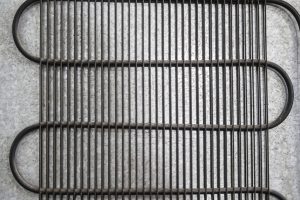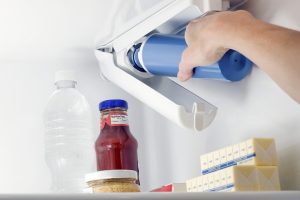Refrigerators are one of the most used appliance in the home. With our refrigerator maintenance tips we’ll show teach how to keep the refrigerator in great shape.
If your refrigerator maintenance routine involves simply re-stocking it with food and beverages from time to time, you might want to reconsider your approach. A refrigerator is one of the few household appliances that runs continually, so keeping it in tiptop shape is especially important. Taking a few minutes on a regular basis to perform some simple maintenance tasks will help your unit run more efficiently, helping to save on energy costs and expensive refrigerator repair bills. Proper maintenance can also help minimize wear and tear to the appliance and help you avoid refrigerator issues, which may increase its lifespan. Here are some fridge maintenance steps to put into practice at your house:

External air-cooled condenser used in water cooler or refrigerator
Clean the coils
Although you may not be able to see the coils, keeping them free of dust, debris, and pet hair really does help the refrigerator operate more smoothly and efficiently. The coils are usually located at the bottom of the unit or in the back. You may have to remove a grill to get to them, but usually that just involves snapping off a plate or removing a few simple screws. If your unit’s coils are in the back, you may have to roll or move the unit away from the wall, which also gives you the chance to clean the floor underneath the fridge. You can purchase a special coil-cleaning tool for the job, but a vacuum cleaner attachment or a stiff brush can also do the trick. Just run the vacuum or brush over and under the coils, removing dust as you go. Clean the condenser fan, too. The coils should be cleaned in this manner once or twice a year, and more often if you have pets that shed.
Maintain the temperature
Check the temperature often in both the refrigerator and freezer sections of your unit. This is important for food safety as well as for helping the fridge run efficiently. The refrigerator compartment should be around 37 to 40 degrees Fahrenheit and the freezer section should be set at zero degrees Fahrenheit. If you have an older model or if you suspect that your fridge or freezer isn’t cooling correctly, you can purchase an inexpensive refrigerator thermometer at most hardware and home improvement stores.
Check the gasket
If your gasket isn’t sealing well, cold air can be escaping, which makes the unit work harder and use more energy to maintain the right temperature. Inspect the gasket frequently for signs of wear and tear. If it’s cracked or deteriorated, you should replace it to avoid refrigerator problems. Clean the gasket regularly with warm, soapy water to help prevent crumbs and spills from harming the seal.

Change filters
Many people don’t realize that refrigerator ice makers and water dispensers usually have filters that need changing. Check your manufacturer’s instructions for specific recommendations and replacement information for your model. Keeping the filters changed will help keep your icemaker and water dispenser clean and will help these components run efficiently. A good way to remember to change your fridge filters is to do it when you change other filters around your home.
Close the door
As it turns out, your mother was right – keeping the refrigerator door closed is a good idea because the refrigerator has to work harder to maintain the correct temperatures when the door is opened frequently. Think about the items you need out of the fridge before you open the door, and retrieve them all at once. Make sure the door is closed tightly when you’re through.
Stay level
If your refrigerator is not level, the doors may not close completely or seal properly, and the motor may have to strain unnecessarily. Use a level tool on the shelves to check your refrigerator’s position. Adjust the feet of the refrigerator if necessary to keep the unit even on all sides.
Cover food
Store food properly in containers with securely fitting tops, or covered tightly with foil or plastic wrap. This will help minimize moisture in the unit.
Fill it
While you don’t want to overcrowd your refrigerator or freezer, keeping the contents full will actually help the unit cool better and operate more efficiently. When filling your refrigerator and freezer, be careful not to block the any vents or controls.
Empty the ice
While this won’t help your freezer run any more efficiently, it may help your drinks taste better. Oftentimes, the ice at the top of the dispenser container gets used while the ice on the bottom just sits there for long periods and becomes stale. Empty the entire container periodically and let it refill from the bottom to make sure all the ice stays fresh.
Light it up
You may not think that working light bulbs will make a big difference, but if you can’t see what you’re looking for inside the refrigerator, you may keep the door open longer. Change any interior light bulbs that burn out promptly so that your family members don’t have to fumble around in dark shelves and drawers.
Cool down
Placing hot, steaming food in your fridge will raise the temperature of the unit and of the contents, making the appliance work harder to stabilize. While food safety is very important, take a few minutes to let hot items cool down before storing them in your refrigerator.
Refrigerator placement
It’s not possible to always choose where your refrigerator will go in your kitchen, but if you get the chance, place it away from the cooktop, oven, or heating source. If a refrigerator is close to any of these heat-generating items, it will just have to work harder to keep the contents cold and use more energy in the process. Also, ensure that it has adequate space around it to allow the vents to function correctly. You don’t want cabinets or other appliances to crowd the unit too closely and impede its operation.
Even if you perform regular maintenance, pay attention to any warning signs that you may be headed for a broken refrigerator, such as:
• Food and drink items aren’t as cold as they normally are
• Soft ice cream
• Melted ice or cubes that stick together
• Food starts spoiling early
• Water around the unit
• Unusual noises or clicking sounds
If you notice any of these signs, it may be time to call a qualified refrigerator repair professional for help. Even if these signs aren’t present, it may be time to consider an appliance warranty to cover everyday household appliances.
All rights reserved to the initial publisher for AHS
Collected and published by Arms &McGregor International Realty® editorial team. Get in touched with us at [email protected]

